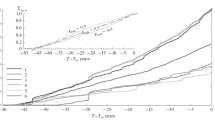Abstract
Based on the uniform catalogue of earthquakes of the minimum energy class 8.5 for 1962–2008, multiharmonic models of seismic activity in Kamchatka are developed. The main harmonic components with periods from a few days to 12 years are identified. Both the entire catalogue and its modified versions obtained by the elimination of aftershocks and clusters, as well as nonoverlapping time series were used to study the stability of the models. The forward-prediction testing showed that in the models with weekly averaged initial data, periods of increased and reduced seismic activity lasting for several weeks are predicted with high confidence on an interval of up to 1.8% of the education period. This testifies for the presence of deterministic components in the seismic activity.
Similar content being viewed by others
References
Bak, P. and Tang, Ch., Earthquakes as self-organized critical phenomena, J. Geophys. Res., 1989. vol. 94, pp. 15635–15637.
Balakrishnan, A.V., Kalman Filtering Theory, New York: Springer-Verlag, 1984.
Bollerslev, T., Generalized Autoregressive Conditional Heeroskedasticity, Journal of Econometrics, 1986, vol. 31, pp. 307–327.
Bollerslev, T., Engle, R., and Nelson, D., ARCH Models, San Diego: University of California, 1993.
Butov, A.A., Some Probabilistic Problems Arising In the Model Construction, Obozrenie Prikladnoi I Prom. Mat., 1997, vol. 4, no. 1, pp. 5–17.
Daubechies, I, Ten Lectures on Wavelets, Philadelphia, PA: Soc. for Ind. and Appl. Math., 1992.
Fedotov, S.A., Energeticheskaya klassifikatsiya Kurilo-Kamchatskikh zemletryasenii i problema magnitud (The Energy Classification of Kuril-Kamchatka Earthquakes and the Magnitude Problem), Moscow: Nauka, 1972.
Guo, J.Y., Greiner-Mai, H., Dierks, O., et al., Application of the Folding-Averaging Algorithm for the Determination of the Periods of the Earth’s Free Oscillation Using Superconducting Gravimeter Data, Bulletin d’Information des Mares Terrestres (BIM), 2005, vol. 139, pp.11025–11036.
Hurst, H.E., Long-term Storage Capacity of Reservoirs, Transactions of the American Society of Civil Engineers, 1951, no. 116, pp. 770–799.
Kuksenko, V.S., A Model of Transition from Micro to Macro Failure in Solids, Sb. dokl. I Vsesoyuzn. shk.-seminara “Fizikaprochnosti i plastichnosti” (Proc. I All-Russian School Seminar “Physics of Strength and Plasticity”), Leningrad: Nauka, 1986.
Lyubushin, A.A., Pisarenko, V.F., Ruzhich, V.V., and Buddo, V.Yu., Identification of Periodicities in Seismic Regime, Vulkanol. Seismol., 1998, no. 1, pp. 62–76.
Lyubushin, A.A., Wavelet-Aggregated Signal and Synchronous Peaked Fluctuations in Problems of Geophysical Monitoring and Earthquake Prediction, Fiz. Zemli, 2000, no. 3, pp. 20–30 [Izv. Phys. Earth (Engl. Transl.), 2000, vol. 36, no. 3, pp. 204–213].
Lyubushin, A.A., Analiz dannykh sistem geofizicheskogo i ekologicheskogo monitoringa (Analysis of the Data of Geophysical and Ecological Monitoring Systems), Moscow: Nauka, 2007.
Molchan, G.M. and Dmitrieva, O.E., Identification of Aftershocks: A Review and New Approaches, Vychislit. Seismologiya, 1991, no. 24, pp. 19–50.
Naimark, Yu.I. and P.S. Landa, Stokhasticheskie i khaoticheskie kolebaniya (Stochastic and Chaotic Oscillations), Moscow: Nauka, 2009.
Nicolis, G. and Prigogine, I., Self-Organization in Non-Equilibrium Systems, New York: Wiley-Interscience, 1977.
Ott, E., Chaos in Dynamic Systems, 2002, Cambridge University Press.
Saltykov, V.A., Sinitsyn, V.I., and Chebrov, V.N., High-Frequency Seismic Noise from Monitoring in Kamchatka, Fiz. Zemli, 1997, no. 3, pp. 39–47 [Izv. Phys. Earth (Engl. Transl.), 1997, vol. 33, no. 3, pp. 205–212].
Smirnov, V.B., Experience of Estimating the Representativity of the Catalogues of Earthquakes, Vulkanol. Seismol., 1997, no. 4, pp. 93–105.
Sobolev, G.A. and Zav’yalov, A.D., On the Concentration Crierion of Seismogenic Ruptures, Dokl. Akad. Nauk SSSR, 1980, vol. 252,no. 1, pp. 69–71.
Sobolev, G.A. and Ponomarev, A.V., Fizika zemletryasenii i predvestniki (Physics of Earthquakes and the Precursors), Moscow: Nauka, 2003.
Sobolev, G.A., Evolution of Periodic Variations in the Seismic Intensity before Strong Earthquakes, Fiz. Zemli, 2003, no. 11, pp. 3–15 [Izv. Phys. Earth (Engl. Transl.), 2003, vol. 39, no. 11, pp. 873–884].
Sobolev, G.A., Microseismic Variations Prior to a Strong Earthquake, Fiz. Zemli, 2004, no. 6, pp. 3–13 [Izv. Phys. Earth (Engl. Transl.), 2004, vol. 40, no. 6, pp. 455–464].
Sobolev, G.A., Lyubushin, A.A., and Zakrzhevskaya, N.A., Synchronization of Microseismic Variations within a Minute Range of Periods, Fiz. Zemli, 2005, no. 8, pp. 3–27 [Izv. Phys. Earth (Engl. Transl.), 2005, vol. 41, no. 8, pp. 599–621].
Sornette, D. and Sammis, C.G., Complex Critical Exponents from Renormalization Group Theory of Earthquakes: Implications for Earthquake Predictions, J. Phys. I. France, 1995, vol. 5, pp. 607–619.
Tyupkin, Yu.S., Modulation of Weak Sesmicity by Tidal Strains Before Strong Earthquakes, Vulkanol. Seismol., 2002, no. 3, pp. 3–10.
Valeev, S.G., Regressionnoe modelirovanie pri obrabotke nablyudenii (Regression Modeling in the Processing of Observations), Moscow: Nauka, 1991.
Valeev, S.G. and Kurkina, S.V., Program Implementation of DRM approach for Processing and Analysis of Time Series, Izv. Vyssh. Uchebn. Zaved., Geod. Aerofotos’emka, 2006, no. 5, pp. 10–21.
Valeev, S.G. and Faskhutdinova, V.A., Statistical Models of the Dynamics of Seismic Activity, Sb. dokladov IV mezhdun. konf. Solnechno-zemnye svyazi i predvestniki zemletryaseniiU (Proc. IV Int. Conf. on Solar-Terrestrial Coupling and Precursors of Earthquakes), Petropavlovsk-Kamchatskii: IKIR DVO RAN, 2007.
Valeev, S.G. and Faskhutdinova, V.A., Modification of the AS DRM Program Complex As Applied to the Processing of Solar and Geophysical Data, Vopr. Sovremennoi Nauki I Praktiki, 2008, no. 2(12), pp. 64–68.
Yarushkina, N.G., Osnovy teorii nechetkikh i gibridnykh sistem (Introduction to the Theory of Fuzzy and Hybrid Systems), Moscow: Finansy i Statistika, 2004.
Author information
Authors and Affiliations
Additional information
Original Russian Text © G.A. Sobolev, S.G. Valeev, V.A. Faskhutdinova, 2010, published in Fizika Zemli, 2010, No. 12, pp. 3–18.
Rights and permissions
About this article
Cite this article
Sobolev, G.A., Valeev, S.G. & Faskhutdinova, V.A. Multiharmonic model of seismic activity in Kamchatka. Izv., Phys. Solid Earth 46, 1019–1034 (2010). https://doi.org/10.1134/S1069351310120013
Received:
Published:
Issue Date:
DOI: https://doi.org/10.1134/S1069351310120013




